The traditional Paraguayan asado and the iconic milanesa are gradually disappearing from family tables due to the ongoing rise in beef prices. According to official data, red meat cuts saw an average increase of 10.5% over the past year, though actual market prices show spikes exceeding 30% in higher-quality cuts.
This trend has led to a significant shift in consumer habits. Many Paraguayans are opting for more accessible protein sources like pork and chicken. Marketing agencies report that numerous restaurants and food stalls are adapting their menus to include these alternatives, especially in popular dishes like milanesas, in order to maintain affordable prices for consumers.
National Consumption Impact
Beef consumption in Paraguay has dropped noticeably, from 55 kg to 50 kg per capita over the past two years, according to industry estimates. Despite this decline, Paraguay remains among the top global consumers of red meat, reflecting its deeply rooted culinary culture.
The National Animal Health and Quality Service (Senacsa) reports that Paraguay produced over 600,000 tons of beef in 2024, reinforcing its position as a major global exporter. Key export markets include Chile, Russia, Taiwan, and the European Union, underscoring the international importance of the Paraguayan livestock sector.
However, this export success presents a dilemma for the domestic market. While international prices remain attractive for producers, local consumers are finding it increasingly difficult to afford a product that has long been a staple of the Paraguayan diet.
Drivers Behind the Price Surge
The persistent rise in beef prices in Paraguay stems from several contributing factors. These include higher production costs—such as feed, fuel, and fertilizers—and growing international demand that reduces the volume available for local consumption.
The Paraguayan Meat Chamber (CPC) notes that the average price per kilogram for popular cuts like asado or lomo ranges between 40,000 and 50,000 guaraníes (roughly USD 5–6.50), depending on the region and cut. For many Paraguayan families, these prices represent a financial strain, given the country’s average income levels.
Follow us on Instagram.
Some cattle industry players have raised concerns about a possible pricing oligopoly, alleging that a small group of actors may be influencing local market prices. These claims have reached the National Commission for Competition Defense, though no conclusive actions have been taken to date.
Balancing Export Growth and Local Access
Despite the challenges, Paraguay’s livestock sector remains a cornerstone of the national economy. Experts agree that striking a balance between external demand and domestic affordability is essential for the sustainable development of the beef industry.
The current situation raises important questions about the future of beef consumption in Paraguay. Public policies and private sector strategies must aim to keep prices accessible without compromising producers’ profitability—an increasingly delicate yet crucial balance needed to safeguard both the country’s culinary traditions and the international competitiveness of its livestock sector.
El artículo en español aquí.









